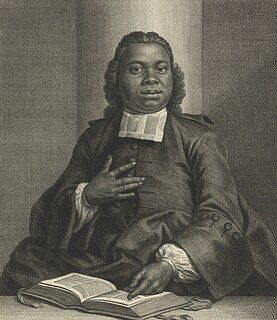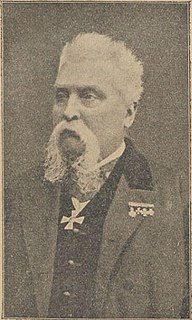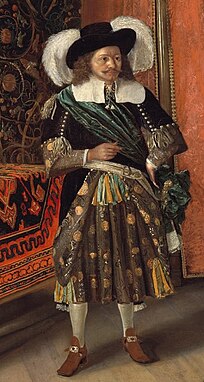
Elmina Castle was erected by the Portuguese in 1482 as São Jorge da Mina Castle, also known simply as Mina in present-day Elmina, Ghana. It was the first trading post built on the Gulf of Guinea, and the oldest European building in existence south of the Sahara. First established as a trade settlement, the castle later became one of the most important stops on the route of the Atlantic slave trade. The Dutch seized the fort from the Portuguese in 1637, after an unsuccessful attempt to the same extent in 1596, and took over all of the Portuguese Gold Coast in 1642. The slave trade continued under the Dutch until 1814. In 1872, the Dutch Gold Coast, including the fort, became a possession of the British Empire.

Cape Coast Castle is one of about forty "slave castles", or large commercial forts, built on the Gold Coast of West Africa by European traders. It was originally built by the Swedes for trade in timber and gold, but later used in the trans-Atlantic slave trade. Other Ghanaian slave castles include Elmina Castle and Fort Christiansborg. They were used to hold slaves before they were loaded onto ships and sold in the Americas, especially the Caribbean. This "gate of no return" was the last stop before crossing the Atlantic Ocean.

Elmina, also known as Edina by the local Fante, is a town and the capital of the Komenda/Edina/Eguafo/Abirem District on the south coast of Ghana in the Central Region, situated on a bay on the Atlantic Ocean, 12 km (7.5 mi) west of Cape Coast. Elmina was the first European settlement in West Africa and it has a population of 33,576 people.
Jacob Elet was a Dutch Chief factor for the Dutch West India Company on the Slave Coast of West Africa during the 18th century who is especially known for having visited in 1733 Agaja, the king of Dahomey, and for having kept a diary chronicling the trip.

Jacobus Elisa Johannes Capitein was a Dutch Christian minister of Ghanaian birth who was one of the first known sub-Saharan Africans to study at a European university and one of the first Africans to be ordained as a minister in the Dutch Reformed Church. He is credited with spreading the use of the written word in his native Ghana.
In 1781, Great Britain declared war on the Dutch Republic, opening the Fourth Anglo-Dutch War. As part of its offensive strategy, the British organized an expedition against Dutch colonial outposts on the Gold Coast of Africa. Captain Thomas Shirley led the expedition, commanding HMS Leander and several transports carrying two small regiments of independently raised troops under the command of Captain Kenneth Mackenzie of the 78th Foot.

The Anglo-Dutch Gold Coast Treaty of 1867 redistributed forts along the Dutch and British Gold Coasts in order to concentrate the parties' areas of influence. All forts to the east of Fort Elmina were adopted by Britain, and all forts to the west by the Netherlands.

The Dutch Slave Coast refers to the trading posts of the Dutch West India Company on the Slave Coast, which lie in contemporary Ghana, Benin, Togo and Nigeria. The primary purpose of the trading post was to supply slaves for the plantation colonies in the Americas. Dutch involvement on the Slave Coast started with the establishment of a trading post in Offra in 1660. Later, trade shifted to Ouidah, where the English and French also had a trading post. Political unrest caused the Dutch to abandon their trading post at Ouidah in 1725, now moving to Jaquim, at which place they built Fort Zeelandia. By 1760, the Dutch had abandoned their last trading post in the region.
Jan Niezer (1756–1822) was a famous and influential Afro-European trader in the Dutch Gold Coast. In his day and age, he was the richest Mulatto trader on the Gold Coast. Furthermore, Niezer was an important political figure during the Ashanti wars of the early 19th century. His most important trade interest was the Atlantic slave trade, until it was abolished by the Netherlands in 1814.

Cornelis Johannes Marius Nagtglas was a Dutch politician and civil servant, who made a career in the administration on the Dutch Gold Coast. After originally beginning his career at the rather advanced age of 36, he was promoted through the ranks to eventually become Governor of the Dutch Gold Coast in 1858. He retired to the Netherlands in 1862, but returned to the Gold Coast as governor in 1869, to restore order in the embattled colony. In 1871, he left the Gold Coast again, one year before the transfer of the colony to the United Kingdom.
Jan Pieter Theodoor Huydecoper was an administrator of the Dutch West India Company. He served as Director-General of the Dutch Gold Coast between 1759 and 1760 and from 1764 until his death in 1767.

Carel Hendrik Bartels was the wealthiest and most important Euro-African trader and businessman on the Dutch Gold Coast in the second quarter of the nineteenth century. Apart from his entrepreneurial activities, Bartels was also a judge and member of the colonial government in Elmina, making him one of the most important men in town.
David van Nyendael, also van Nijendael, was a Dutch mulatto merchant and diplomat in the service of the Dutch West India Company, and stationed at the Dutch Gold Coast.
The Dutch–Ahanta War was a conflict between the Netherlands and the Ahanta between 1837 and 1839. Beginning with a mere economic dispute between the Ahanta and the Dutch, who were based at the Dutch Gold Coast, the conflict ended with the hanging of Ahanta king Badu Bonsu II and the reorganization of the Ahanta state, establishing a Dutch protectorate over the Ahanta.
George Emil Eminsang was a prominent Euro-African merchant and political leader on the Gold Coast, who played a prominent role in the last years of Dutch colonial rule on the Gold Coast. After the Dutch Gold Coast was transferred to the United Kingdom, Eminsang became a diplomat for the Netherlands and later the United States and the Congo Free State. Together with James Bannerman Hyde and James Hutton Brew, Eminsang was one of the first so-called "country lawyers" on the Gold Coast.
Anthony van der Eb was a Dutch civil servant, who made a career in the administration on the Dutch Gold Coast.

Willem George Frederik Derx was a Dutch civil servant, who made a career in the administration on the Dutch Gold Coast.

Dirck Dircksz. Wilre was a Dutch smuggler who joined the Dutch West India Company in 1662, and who quickly climbed the ranks to become acting Director-General of the Dutch Gold Coast in 1662. He eventually was installed as full Director-General in 1668.
Pieter Simon Hamel was a Dutch diplomat who served as Consul General at Elmina, Bangkok and Amoy.














